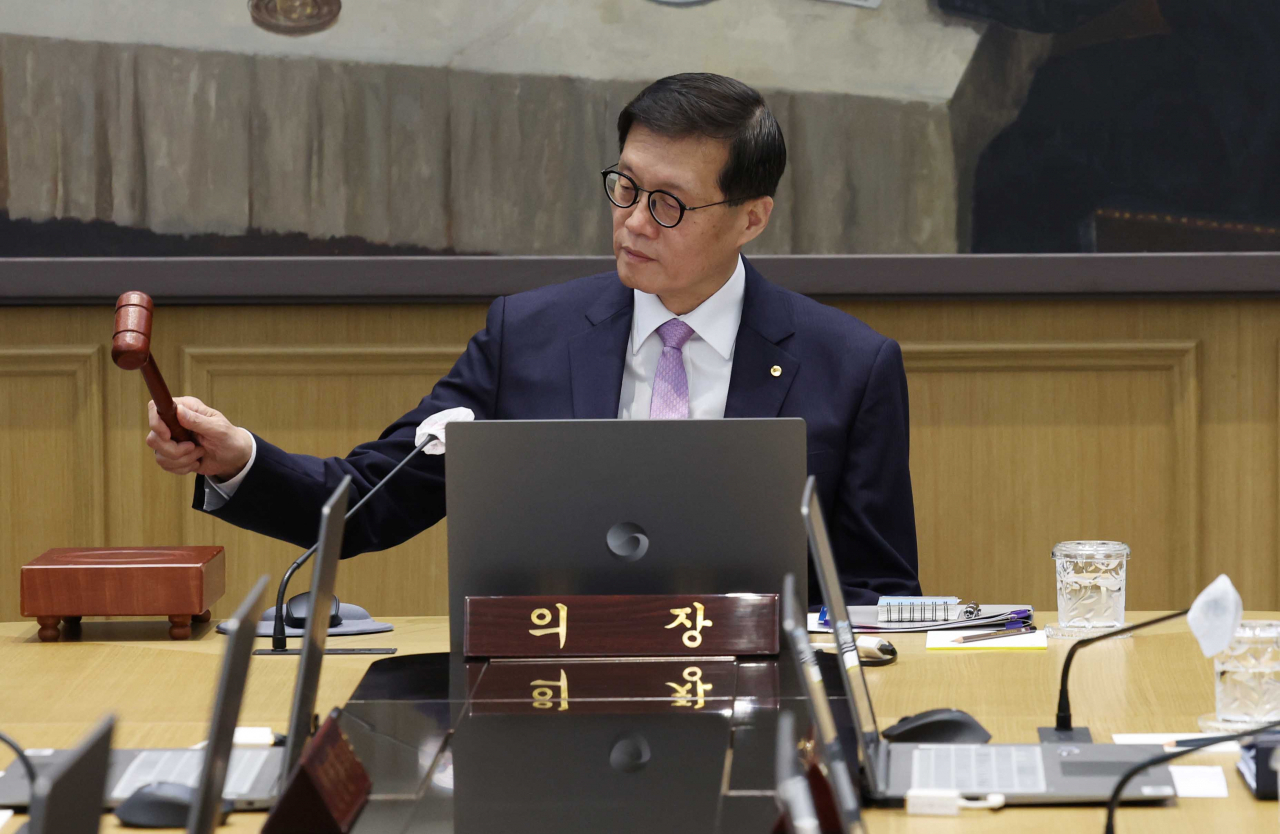 |
Bank of Korea Gov. Rhee Chang-yong bangs the gavel at a monetary policy board meeting held at the central bank's headquarters in Seoul, Friday. (Joint Press Corps-Yonhap) |
South Korea's central bank lowered the policy rate by 0.25 percentage point on Friday, signaling the end of an era of monetary tightening that had extended over three years.
The Bank of Korea’s monetary policy board slashed the base rate by 25 basis points, bringing it down to 3.25 percent. Five of the other six monetary policy board members, not including BOK Gov. Rhee Chang-yong, agreed to the rate cut, while the remaining member suggested maintaining the rate at the 3.5 percent level.
It was the first time the central bank has lowered the rate since the rate hike cycle began in August 2021. The BOK had maintained a tight grip on monetary policy to combat inflation.
An easing in price gains enabled the rate cut. Korea’s consumer price index, a key gauge of inflation, rose 1.6 percent on-year in September, falling below the 2 percent target level set by the BOK for the first time in more than three years.
“When the base rate was raised to 3.5 percent, the inflation level had reached 6 percent,” Rhee said at a press conference Friday, referring to monthly consumer price growth.
“With the price gain standing at around 2 percent, the current level of base rate is relatively high in terms of the real interest rate.”
The rate decision follows a historic half-point rate reduction by the US Federal Reserve last month, which marked the first cut by the Fed in over four years. The US federal funds rate now stands at a range of 4.75 percent to 5 percent.
Though the Fed surprised the market with its larger-than-expected rate cut, Rhee stressed that the BOK will not necessarily follow in the footsteps of its American counterpart.
“The US had raised the rate by 500 basis points, responding to over 10 percent inflation. Its rate cut would be faster, considering Korea had raised the rate by 300 basis points and its inflation peaked at 6 percent,” Rhee explained.
With the lowered key rate, the maximum interest rate gap between Korea and the US stands at 1.75 percentage points, a quarter percentage point higher than the previous 1.5 percentage points.
Despite the decision to slash the rate, Rhee maintained a hawkish tone, refraining from hinting at a further rate reduction in the near future.
“Considering concerns of financial stability, the rate reduction could be interpreted as a hawkish rate cut,” he said.
Surging household debts remain a hurdle for the central bank. As of the end of September, the size of outstanding household loans extended by the top five lenders here had reached 730.96 trillion won ($541 billion), marking a 5.6 trillion won increase from the previous month.
“The BOK will keep watch on how the rate cut will affect financial stability,” Rhee said. “Five out of the six members of the monetary policy board viewed the rate should remain at around the current level of 3.25 percent in the next three months. One member suggested to further lower the rate.”
Yet the market remained optimistic that the central bank has embarked on a rate cut cycle.
Analyst Ahn Ye-ha from Kiwoom Securities projected that the BOK is likely to further pull down the rate next year, while keeping it steady at the next rate-setting meeting slated for November.
"If disinflation continues, the BOK is likely to further ease down on its monetary policy, with additional rate cuts in the first and second quarter of next year, respectively," Ahn said.
"The BOK said it will control the pace of rate reduction based on the financial circumstances. But as long as the government’s prudential policies are effective, the BOK will continue to bring down the rate every quarter until the 2.75 percent level, which is slightly higher than the estimate of its neutral rate of 2.5 percent," analyst Yoo Young-sang of Korea Investment & Securities said.







